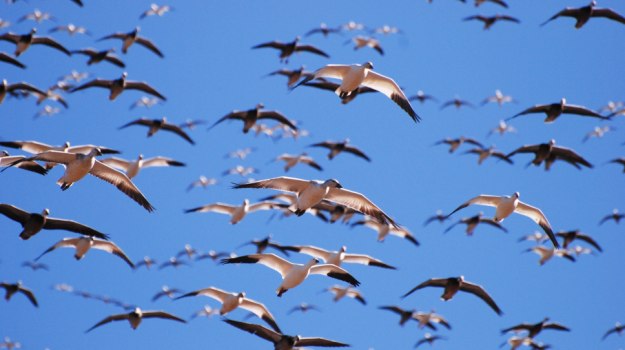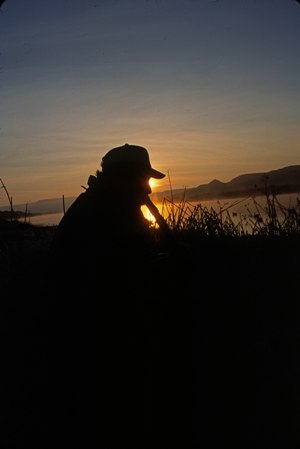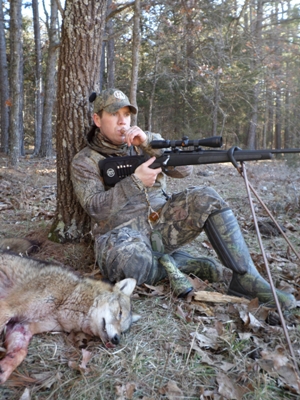
Editor’s Note: Mario Friendy of Sherwood, Oregon, is in charge of all western sales and the Zink Calls Pro Staff in Canada and is the Mossy Oak Pro Staff Regional Manager for waterfowl for the Pacific flyway. Since he was 8-years old, Friendy's been hunting ducks and geese - first with his dad in Pennsylvania where he grew up - and he’s won the Best of the West two-man duck calling championship.
We have very few snow geese coming through the portion of Oregon where I live. So when I want to hunt snow geese, I go to either southern Oregon or the areas around Sacramento, California. Weather determines how good or bad the snow goose hunting will be. If those areas have had lots of dry weather, we hunt dry grain fields and/or dry rice fields. If there’s a normal amount of rainfall, we hunt the flooded rice fields. Regardless of where you hunt snow geese, you need to have really big decoy spreads. We use a lot of floating snow geese decoys, and we mix in some full body decoys. We usually put out at least 200 Avian-X full body decoys. Twenty or 30 years ago all a snow goose hunter had to do was get white sheets, cut them up and put those rags out to decoy in the snow geese. But today, the snow geese have wised up. You can put some rags between some of your full body decoys to have more white on the ground, but I think you definitely need as many full body decoys as you can.
 In the Sacramento region where I hunt are a lot of duck and goose clubs. So, decoying in the snow geese is not as easy as it once was. The more realistic looking your decoys are, the better your chances for bringing in the birds. Usually, we have six or eight hunters on a snow goose shoot, and we’ll put out 300 to 500 decoys. We try to use the wind to our advantage when we’re putting out our decoys, and we leave some clear ground where we want the geese to land. We try to locate our landing zone close to the upwind side of our spread. Snow geese like to come in over the geese on the ground. They want to get to the new ground and feed before the geese on the ground move that way.
In the Sacramento region where I hunt are a lot of duck and goose clubs. So, decoying in the snow geese is not as easy as it once was. The more realistic looking your decoys are, the better your chances for bringing in the birds. Usually, we have six or eight hunters on a snow goose shoot, and we’ll put out 300 to 500 decoys. We try to use the wind to our advantage when we’re putting out our decoys, and we leave some clear ground where we want the geese to land. We try to locate our landing zone close to the upwind side of our spread. Snow geese like to come in over the geese on the ground. They want to get to the new ground and feed before the geese on the ground move that way.
We use our layout blinds and our A-frame blinds, depending on the type cover we have or don’t have, and we also have pit blinds from which we can shoot. We may be in a pit on a levee between two rice fields. So, we have several different ways we can blind-up, depending on where the geese are feeding, and the way the field is configured. In the spring, you can use electronic callers but not in the places I hunt. In the places I hunt, you can only use hand-blown calls. There are many more snow geese that come down the Mississippi flyway than come down the Pacific flyway. So, we can’t harvest as many snow geese as people on other flyways can. The snow goose season usually starts a little bit later than duck season. As a general rule, it usually goes through the end of duck season.
We’re seeing more and more western hunters beginning to hunt snow geese, especially if southern Oregon and California have really dry weather. For the most part, waterfowlers like to pull the trigger on their shotguns. So, if not many ducks are coming down the flyway, many hunters will switch over and start hunting snow geese.
We don’t get a lot of speckled bellies (white-fronted geese) but they get a good number in California. The speckled belly season runs concurrent with the Canada goose season. During the regular goose season, there are a lot of speckled bellies taken in southern Oregon and California.
Day 4: Seven Different Species of Canada Geese - the Good and Bad News



























